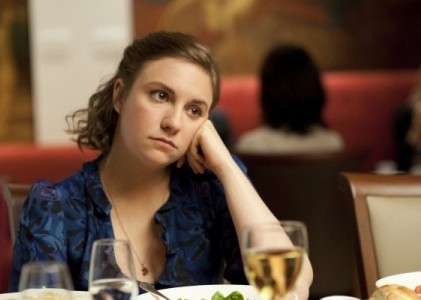An Imagined Life
Girls begins with the image of its central character, Hannah Horvath, slurping pasta into her mouth in the golden light of some Midtown restaurant. She’s at dinner with her parents, Midwestern professors taking the occasion of their visit as an opportunity to inform their aspiring essayist that they’ll no longer be supporting her financially, euphemized by her father as “one final push.” Hannah, two years into a post-collegiate life of unpaid internships, quickly cycles through a range of responses, from pain to bargaining to defiance. “But I’m so close to the life that I want,” she says, before quickly correcting herself: “the life that you want for me.” It’s the first of many moments in the series that express the particular ills of personal relations in our brave new economy—here the shame and confusion of children, the guilt and exasperation of parents. The people I know who like Girls the most tend to speak of it in pained terms, equally appreciate of and disgusted by its proximity to their lives.
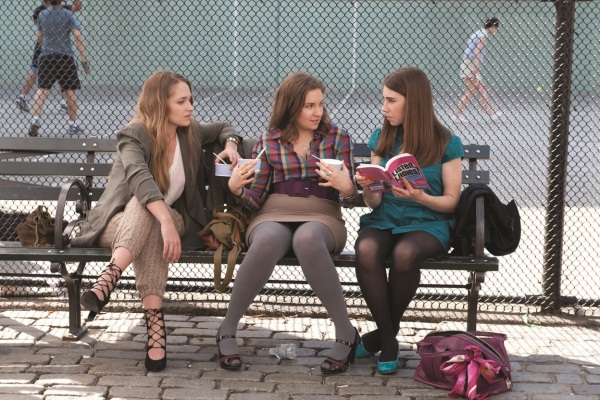
Jemima Kirke, Lena Dunham and Zosia Mamet in Girls
The young woman shoveling pasta is Lena Dunham, the show’s star, writer, producer, and frequent director. In less than five years Dunham has gone from an Oberlin undergrad uploading YouTube videos to helming an HBO series bearing the approval of comic heavyweight Judd Apatow, the show’s executive producer, and her ascent has been both driven and documented by a culture industry that has found in her a wellspring of readymade hooks. Dunham’s advantages in life (she’s the daughter of New York artists Carroll Dunham and Laurie Simmons) exist in the cultural consciousness in a way unmatched by almost any other contemporary artist. Little of the writing on Girls (which just concluded its first season) and Tiny Furniture, the independent feature that shot her to stardom in 2010 (and is available on DVD through the Criterion Collection), seems able to see beyond her life to the work itself; it’s a failing that’s as obvious in the stream of shallow profiles as in the click-bait handwringing over her work’s homogenous milieus.
Beyond all this white noise there have been a handful of pieces of note. Linda Martin Alcoff’s take for The Feminist Wire works through the conceptual capacities of the show’s many contradictions with a cool head. Richard Brody’s weekly recaps are as thoughtful and sensitive an explication of what I take to be Dunham’s creative desires as I can imagine the show receiving. Elizabeth Gumport’s essay on Tiny Furniture in N1FR, “Made in Manhattan,” is the most thorough account of Dunham’s thought I’ve encountered, though in the end it settles for her easiest ideas, sliding the blinders of privilege back on after spending a couple thousand words systemically unpacking the very idea of privilege. In all three of these cases there’s a sense of the author moving productively in the same direction as Dunham’s thought. I would like to offer a counter-reading, a movement against the grain, one that leaves behind intentionality to consider the political currents shaping the work.
Filmed on location in her family’s Tribeca loft, with her mother and sister playing her mother and sister, and starring Dunham as an aspiring video artist returning home after graduation, Tiny Furniture openly courts autobiographical readings. The distance between the characters and their relations and reality is ultimately irrelevant as anything more than psychotherapy for Dunham. What’s critical to an understanding of how both the film and the series work is the way that Dunham and her director of photography, Jody Lee Lipes (who has also shot all of Girls to date), present these places.
The loft where the majority of the film occurs isn’t the place of warmth that one might expect from a home; as captured by Lipes’s severe widescreen frame it has an opacity that hides any trace of messy life. Even the most casual scenes—conversations in bed, Dunham flopping down on the floor after a fight with her mother—have a tidy geometry to them, the careful compositions an extension of this perfectly ordered space.
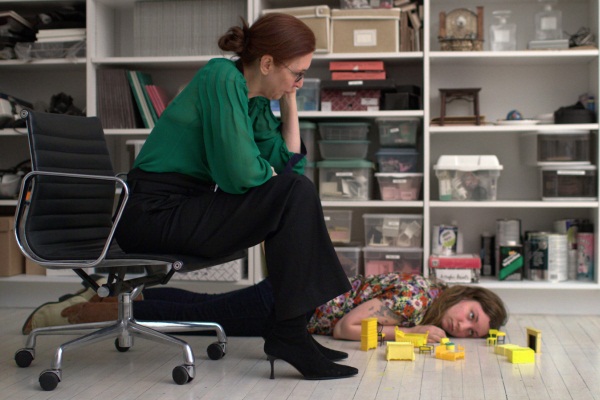
Laurie Simmons and Lena Dunham in Tiny Furniture
One of the film’s many visual jokes comes when Dunham’s Aura, standing in front of an entire wall made of white cabinets, is instructed by her mother to look for a light bulb… “in the white cabinet.” It’s a cheap gag, but one that, in light of Aura’s eventual decision to live at home instead of moving to Brooklyn with her best friend, is rich with meaning. Aura’s choice, which comes with the freedom from financial worry inherent in living at home, is, as Gumport describes it, “Manhattan over Brooklyn, art over hobbies. And why shouldn’t she? Just because some people overcome obstacles in order to succeed doesn’t mean obstacles are necessary to success.”
The life Aura chooses is both clean and existentially terrifying: she’s chosen to make art in a space that, at best, will reflect back her own image, if it offers one at all. It’s in recognizing this that Gumport collapses the process of Dunham’s experience with the realities that, in making this choice, will continue to lie outside of it: “We ought instead to be inspired by Dunham’s allegiance to her own experience—to having it, to recording it. If we’re not, perhaps that’s because it wakes in us the dormant worry that we’ve betrayed our own. The value Tiny Furniture places on ordinary existence calls all of us to account. Which life did you leave unlived?”
Aura has chosen a life of art that reflects itself, just as Lena Dunham has chosen the same in making Tiny Furniture. And if she’s made a film worth considering, it’s because of what it can tell us about this situation, not what we might find to ask ourselves in it.
And so these endless white cabinets become a totem for a whole system of living: as Aura blindly rummages through them she finds her mother’s diary, her nakedly recorded remembrances of flings and anxieties. These memories, which she acknowledges with something like detached embarrassment when Aura confesses to reading them, are tucked away behind a perfectly manicured life, a wall of tidiness and manners and interior decorating and exhaustively controlled art (Simmons’s photography, which appears in the film, makes extensive use of miniatures) to keep out all the messier parts of life. Even as Aura attempts to let some of the mess back in, fucking a former coworker in a piece of drainage pipe on a construction site, there’s a sense that her life is being lived at a remove: this experience takes on scare quotes, it’s lived and remembered less as an event than as an attempt at doing something real. It’s this emptiness—the ticking clock that ends Tiny Furniture—that Girls’ vision of Brooklyn, land of beautiful uncertainty, springs from and responds to.
The root of this uncertainty for Hannah, the point around which the whole series orbits, is financial. It’s there from that first image of Hannah stuffing pasta into her mouth. She is the daughter of parents who are stable enough to afford a $300 a night room at the Warwick and to indulge her with the sort of dinner one living on an allowance can't normally afford but not so well off that they can support her indefinitely through a career of internships as she completes a memoir. This push toward a life where she will not be able to solely focus on her art without worry for shelter or sustenance sets in motion Dunham’s overriding concern with the complexities of a life lived for art. (It’s this exploration that Brody has given thorough consideration to in his weekly roundups.) Having lost, or been freed from, this support structure, she’s been forced to give up experimenting and start experiencing. Her inability to separate the art that will come from these experiences from the moment of living them is the dilemma of her life.
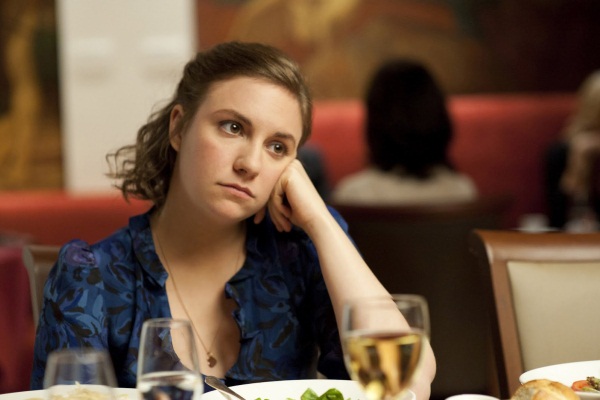
Lena Dunham in Girls
Girls’ texture—it’s shot in the 16:9 ratio customary to today’s widescreen TV and full of grays and browns—is a marked contrast to the opacity of the whites and primaries of the constrictive compositions in Tiny Furniture. Though the intricately invisible production design and consistent use of both long shots and languid, wandering camera movements strive to create a sense of casual, messy life—for precisely this sense of experience—the frequent recourse to schematic overhead shots (whether of the workings of a warehouse party in Bushwick or of three bodies on the verge of a threesome in a luxury apartment in Williamsburg) betray the tension between embodying this reality and imagining it. As so many profiles over the last two years have told us, this isn’t her experience.
The show’s structure is of a piece with the tension of its visual style, stringing together events based on clusters of organically developed relations around the occasional intrusion of overt dramatic mechanisms: the aforementioned financial cutting loose, the discovery and public reading of a diary, a surprise wedding. Its spine is formed by Hannah’s contrasting relationships with her roommate and best friend, Marnie (Allison Williams), and her love interest, Adam (Adam Driver). Hannah and Marnie’s relationship deteriorates slowly, flaming out in an extended, roving argument that maps the space of their entire apartment, the two starting and stopping as if they’re trying to escape all of their resentments even as they’re airing them. It’s both the series’ closest moment so far to Tiny Furniture’s repressive tendencies and its clearest expression of the impact of money on relationships: when Hannah accuses Marnie of not being supportive of her writing in a scene earlier in the episode, Marnie, referencing Hannah’s chronically late rent and lack of steady employment, responds, "Hannah, I support you, literally."
Adam and Hannah’s relationship moves in the opposite direction, though it also ends in limbo. Living off $800 a month from his grandmother and dabbling in theater and carpentry, Adam begins the show as little more than an object to fulfill and highlight Hannah’s desire for experience, which he satisfies almost exclusively in the form of a wide array of non-traditional sexual habits. He moves through a series of small gestures—an understanding phone call, a genuine desire to involve her in his own interests (collecting junk from scrap yards, as it were)—toward becoming an integral part of her life. This arc is completed with a very public apology at the end of a terrible day in the relationship—one in which he embarrasses her in public and pees on her in private—in the form of a pasted-on mural of dozens and dozens of paper signs reading “SORRY,” seen from a high, acute angle directed out toward a vanishing point in the Brooklyn night, a world of possibility ahead of them with his sincere concern for her at its base.
Adam’s appeal for Hannah, more than his emotional intelligence or apparent sexual prowess, comes from his sense of certainty, his ability and willingness to say and do precisely what he wants to at a given movement: his is the exact opposite of the alienated life lived by both Aura and Hannah. It’s there in his presence, which is enormous without being overbearing—he’s simply big. It’s there in his speech, where every syllable has the force of his full conviction behind it. The way he pronounces the word “pseudonym” is a particular thing of beauty.
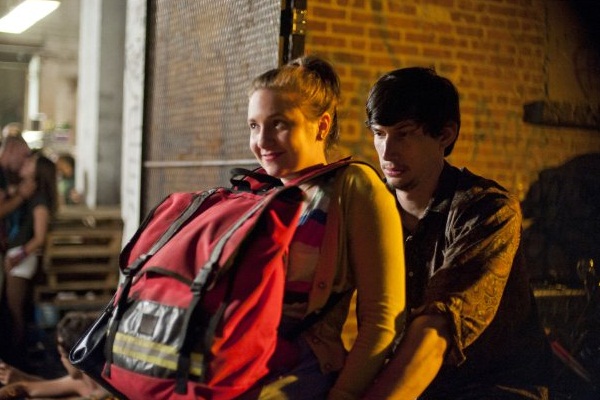
Lena Dunham and Adam Driver in Girls
So when Adam offers to move in after Marnie promptly moves out following the fight, Hannah turns out to be the only person in the world clueless enough to understand that he really wants to live a life with her. She finds another roommate (her gay ex-boyfriend), and expresses her relief at their not living together since she has so many other things she needs to do first. Where Dunham responded to Tiny Furniture by setting Hannah adrift financially in a world of shitty jobs and sexual harassment, the better to live for her art, Hannah herself rejects the settled comfort of a stable relationship—the first step toward an emotionally, financially stable life—for the artistic fodder of an imagined life. Adam’s response is furious, a rain of hurt and anger shot in a series of close-ups that perfectly express her uncertainty and his conviction—his focus is so dogged that the conversation ends with him hit by a van while standing in traffic. As he lays bare her inability to see beyond herself she can only respond by whimpering that she’s “the most scared person who’s alive.” Adam tells her that she doesn’t have any right to be the most scared person who’s alive. A more accurate response would be that she has no reason, but this is the fundamental problem of Dunham’s characters: their terror is truly existential insofar as they are incapable of reconciling inside and out in a way that lets them be in the world. These are profoundly sick characters: sick of themselves, sick with the disease of a class that prefers this inward preoccupation to a view of the masses below. Dunham’s unwillingness to criticize these characters for their illness has drawn her the ire of many critics, who call her a narcissist, an apologist for privilege, or just clueless. Those might all be true, but the fact that she’s aware of these problems and willing to present them so nakedly puts her in a rare class among American filmmakers working today.
The season closes
with Hannah falling asleep on the F train, riding it all the way to
Coney Island. She wakes up to find her purse missing, we don’t see
who’s stolen it, which is very much in line with Dunham’s
romantic idea of Brooklyn itself as a entity that produces problems
to be worked through. She exits the platform and yells at a group of
girls on a nearby rooftop—among the only minorities to appear in
the series so far—to ask where she is; they just laugh. Because
this, like her assertion that she’s the saddest person in the
world, is in its way ridiculous: Where am I?—You’re right
here. It’s the first moment in her work that Dunham has
acknowledged that to even ask such questions is its own privilege,
one that a bunch of working girls from Brooklyn have every right to
laugh at. She continues down to the beach, where she sits alone, shot
from below against a huge, beautiful blue sky, eating cake and
staring out at the waves. ![]()
LATEST ARTICLES
-20140814-173707-thumb3.jpg)
Fighting Words
by Imogen Sara Smith
posted August 12, 2014

Fighting Words, Part 2
by Imogen Sara Smith
posted August 20, 2014

On the Margins: The Fil…
by Andrew Chan
posted August 12, 2014

Robin Williams: A Sense…
by David Schwartz
posted August 12, 2014
 An Imagined Life
An Imagined Life
THE AUTHOR
Phil Coldiron is a writer and programmer living in Brooklyn.
More articles by Phil Coldiron
